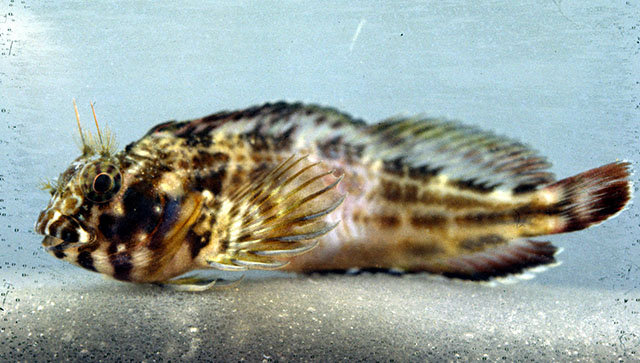| Blenniidae (Combtooth blennies), subfamily: Salariinae |
| 12 cm TL (male/unsexed) |
|
demersal; marine; depth range 0 - 30 m |
| Eastern Central Atlantic: Moanda-Tonde and Crique de Banana, Congo. Mediterranean Sea: Off Naples, Palermo, Alger and coast of Israel. |
|
Diagnosed by having the following characteristics: brown-yellowish body color with five irregular vertical dark bars extending to the lower part of the dorsal fin; remaining part of fin same as body color; head may have some bluish tinge; thick superior upper lip; mark V-like cavity between the eyes; wrinkled dorsal area between the head and the beginning of dorsal fin; caudal fin with a series of alternating light and dark vertical bars; cirri with several branches, grouped in a common base; most developed branch lies at the centre and surrounded by several thinner and shorter branches (Ref. 97253). |
| Adults occur in shallow waters near harbors and on rocky shores of coastal waters (Ref. 5298, 5981). Oviparous. Males are extremely territorial especially when guarding eggs (Ref. 97521). Eggs are demersal and adhesive (Ref. 205), and are attached to the substrate via a filamentous, adhesive pad or pedestal (Ref. 94114). Larvae are planktonic, often found in shallow, coastal waters (Ref. 94114). |
|
Least Concern (LC); Date assessed: 04 February 2009 Ref. (130435)
|
| harmless |
Source and more info: www.fishbase.org. For personal, classroom, and other internal use only. Not for publication.

